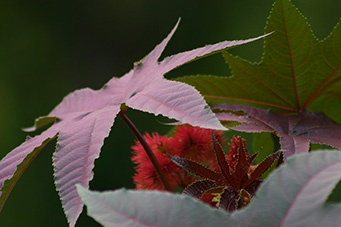| |
UT Gardens’ July 2018 Plant of the Month: The Castor Bean
By Amy Dismukes, UT/TSU Extension, Williamson County
| |

|
| |
With a variety of leaf and flower colors, the castor bean is a experiencing a resurgence among gardening enthusiasts. Photo by A. Dismukes, courtesy UTIA.
|
The castor bean, Ricinus communis, a member of the spurge (Euphorbianceae) family, grown both for its flowers and dramatic foliage, is indigenous to the southeastern Mediterranean, Eastern Africa and India, but the plant can be grown throughout the United States as an ornamental annual.
The name Ricinus is Latin for tick, for which the seed is so named, due to its markings and shape. The common name castor oil is thought to come from its use as an alternative to castoreum, a perfume base derived from the dried glands of the beaver (castor in Latin). Another common name is palm of Christ, or Palma Christi, which speaks to the plant’s castor oil derivative and its reputed ability to heal wounds and cure ailments. Other common names include mole killer plant and castor oil plant.
It is said that the plants were grown in English gardens, beginning around the 16th century, as well as in Egypt, where the oils were utilized as an alternative to lamp oil. In the United States, castor bean plants were grown to produce castor oil, which was used in making soaps, linoleum, nylon, paints and electrical insulations. It was also used to make a military grade aircraft lubricant and was a popular medicine in the first half of the 20th century.
Because the oil itself does not contain ricin, the poison naturally found in castor beans, it has also found its way into the cosmetic world as a benefit for both skin and hair.
Today, when we think of castor bean, most of us think of moles, those annoying little guys responsible for tunneling around your back yard in search of food … probably because castor oil is the main component in many mole deterrent sprays. The effectiveness of these sprays is still up in the air.
Castor bean can vary greatly in both its appearance and growth habits. Over time, breeders have increased this variability by selecting specific cultivars for leaf and flower color, as well as oil production, leading to its new found popularity with gardeners. With its rapid growth rate, some cultivars can reach the size of a small tree in a very short period of time. The giant castors, of course, can surpass those shorter varieties in both height and width.
Dependent on the type of castor you choose to grow, its enormous, glossy palmate leaves can range between anywhere from 6 to 30 inches across, resembling a star, with anywhere from five to 12 deep, coarsely serrated lobes. Each leaf is attached by a slender, long petiole, arranged alternately up the main stalk.
In some varieties the leaves start off a dark, reddish purple, bronze or green, gradually changing to a darker tone as they mature, whereas other varieties offer green leaves from the start.
The stems and alien-like, spiny seed pods also vary in color and are often prettier than the actual blooms. The male flowers are yellowish-green with creamy white stamens, where the female flowers hide within the spiny seed pods, have red stigmas and are produced in lower numbers than the male.
Each fruit is a spiny capsule containing large, bean-like seeds, decorated with a brownish mottling pattern. The seed has a small wart-like appendage called a caruncle, which promotes myrmecochory ― the dispersal of seed by ants.
If you’d like to incorporate castor bean plants into your landscape, sow the seeds in a site with direct sun and deep, rich soil. Alternatively, you may start them early, inside, to get a jump on the growing season, transplanting young plants to a sunny location when the weather is adequate and the possibility of freeze has passed. Make sure to protect the plants from winds that could harm the large, glossy leaves. Castor bean plants love water, so make sure they receive an adequate amount of irrigation should drought be a concern at any time.
The biggest drawback of castor bean is its lack of cold hardiness. As the year goes by and the temperatures begin to drop, you’ll notice your castor bean seems to disappear along with the long daylight hours. You can bring your baby back to life by saving its seeds. Its seed is the castor bean, which, despite its name, is not a true bean.
Using rubber gloves, carefully cut the seed stalk (previous bloom) out, allow the seed pods to dry in a cool, dark and dry room, and crack and remove the seeds carefully. You may store the seeds in a paper envelope, labeled, inside your refrigerator or wherever you store “saved seeds.”
If you want to take a peek before you jump all in, Ricinus communis var. New Zealand Black and Ricinus communis var. Carmencita Red are both grown at the UT Gardens, Knoxville. Ricinus communis var. gibsonii ― my favorite ― makes an annual debut in UT Gardens, Jackson.
All in all, castor bean is a star ― literally! Don’t let the “poisonous” label scare you, as it would take a deliberate act to utilize it as a poison. Unintentional exposure is highly unlikely, except through the ingestion of the beans. So, don’t eat the beans!
The UT Gardens includes plant collections located in Knoxville, Jackson and Crossville. Designated as the official botanical garden for the State of Tennessee, the collections are part of the UT Institute of Agriculture. The Gardens’ mission is to foster appreciation, education and stewardship of plants through garden displays, educational programs and research trials. The Gardens are open during all seasons and free to the public. For more information, see the Gardens website: ag.tennessee.edu/utg.
Published July 8, 2018 |

